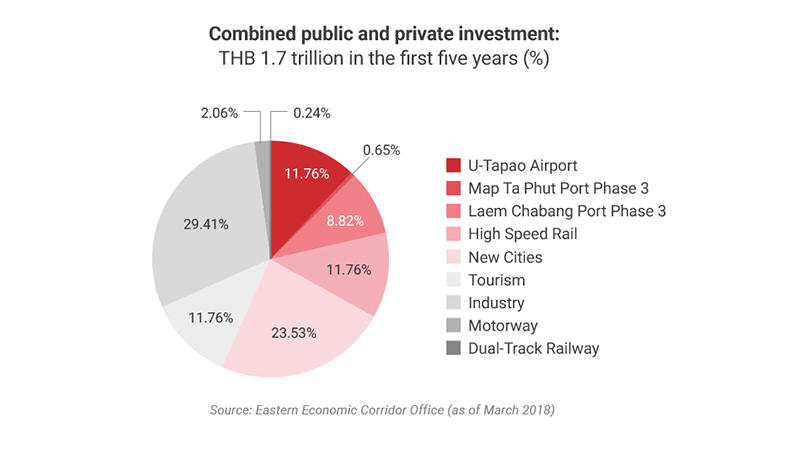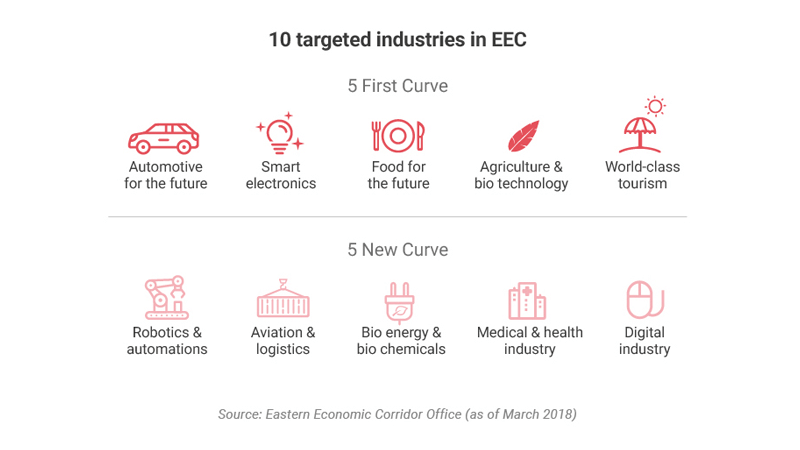One of the recent highlights in Thailand’s infrastructure industry is Eastern Economic Corridor (EEC), a pilot project for the economic development and a response to the rapidly changing business world and the immense power of the Industry 4.0. The EEC project will be one of the significant investment drivers in infrastructure, industrial projects, and social projects. It will strengthen the economic, GDP growth and social development of Thailand.
The plan is a key component of the ‘’Thailand 4.0’’ economic policy announced in 2016, an economic model that aims to unlock the country from several economic challenges resulting from past economic development models. The geographical core focus is placed within the Chachoengsao, Chonburi, and Rayong provinces and the government expects 1.7 trillion Baht to be invested in the development plan in the first five years. The project has ten target industries, ranging from automotive and electronics to automation and robotics.


The aim of the plan is to transform the Thai’s economy into an innovation-driven one and focus on becoming a more service-based economy and move away from labor-intensive industries. The plan has four core focus areas, being infrastructure, business, tourism and new cities, as well as fifteen major projects, with five of them being of high priority and will provide the foundations for subsequent development in the EEC.
One of the high priority projects being the U-Tapao airport development. With the improvements and expansion of the second passenger terminal, the government expects it to usher in a new wave of tourists. Developing the airport further will also expand the ECC’s reach into the aviation sector. There is currently only one passenger terminal, which can support 700,000 passengers per year, and with the expansion of the second passenger terminal, this value will increase to 3 million passengers per year.
The connectivity is a key component of the EEC project, which is why the U-Tapao airport development is of such importance. However, the government is also including the development plans of the Laem Chabang port as a high priority project. The plan is to increase the Laem Chabang port’s connectivity and capacity within the first year of the EEC’s development.
In summary, the EEC will create plenty of opportunities for businesses, whether through direct investments or investing and participation in a Public-Private Partnership (PPP). For instance, the infrastructure and public transportation, which will strengthen the economic and social development of not only Thailand, but also other countries through interconnectivity.
Read more about our consulting services.
The insights provided in this article are for general informational purposes only and do not constitute financial advice. We do not warrant the reliability, suitability, or correctness of the content. Readers are advised to conduct independent research and consult with a qualified financial advisor before making any investment decisions. Investing in financial markets carries risks, including the risk of loss of principal. Past performance does not guarantee future results.
The views expressed herein are those of the author(s) and do not necessarily reflect the company's official policy. We disclaim any liability for any loss or damage arising from the use of or reliance on this article or its content. ARC Group relies on reliable sources, data, and individuals for its analysis, but accuracy cannot be guaranteed. Forward-looking information is based on subjective judgments about the future and should be used cautiously. We cannot guarantee the fulfillment of forecasts and forward-looking estimates. Any investment decisions based on our information should be independently made by the investor.
Readers are encouraged to assess their financial situation, risk tolerance, and investment objectives before making any financial decisions, seeking professional advice as needed.




